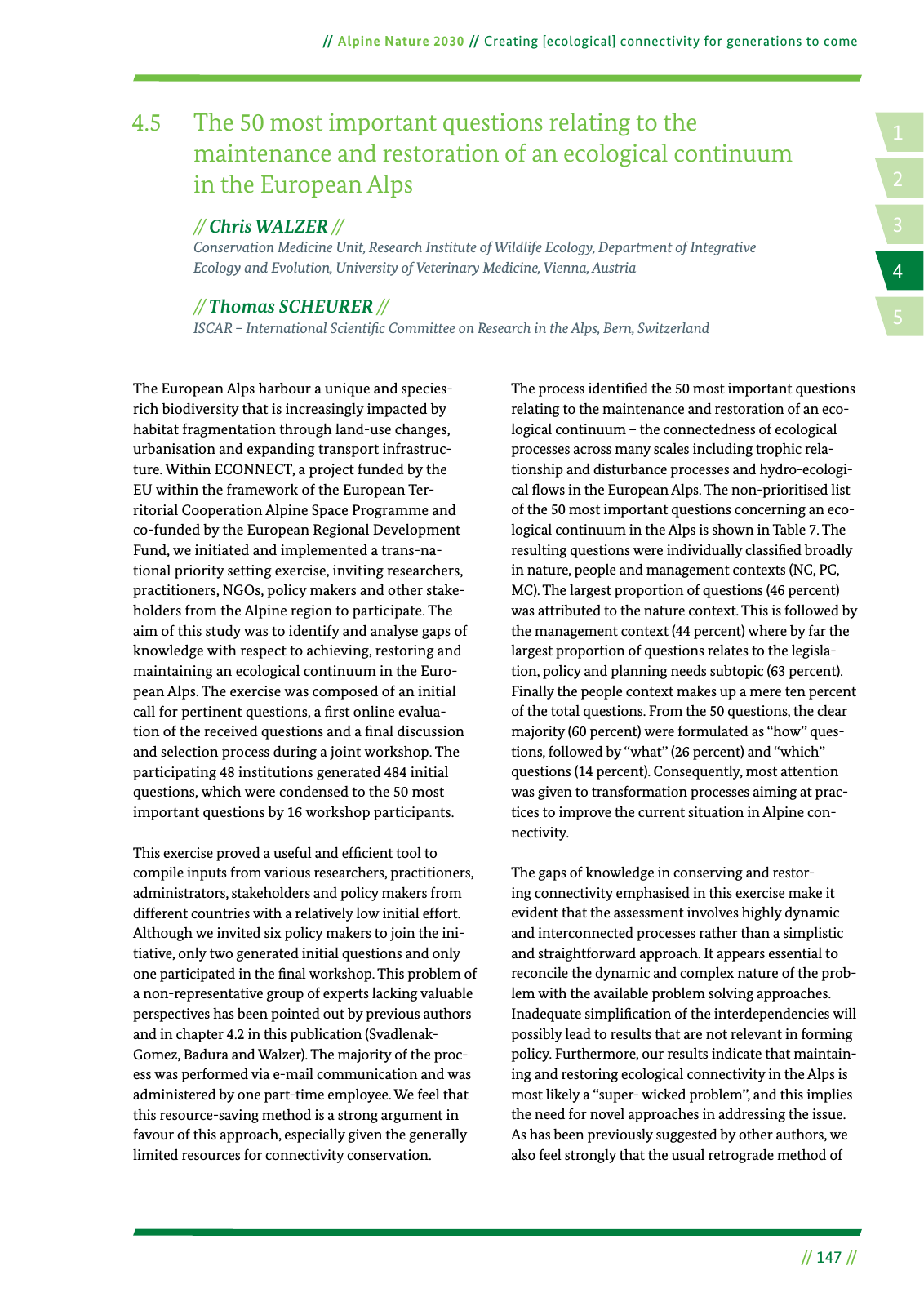14 2 5 3 Alpine Nature 2030 Creating ecological connectivity for generations to come 147 4 5 The 50 most important questions relating to the maintenance and restoration of an ecological continuum in the European Alps Chris WALZER Conservation Medicine Unit Research Institute of Wildlife Ecology Department of Integrative Ecology and Evolution University of Veterinary Medicine Vienna Austria Thomas SCHEURER ISCAR International Scienti c Committee on Research in the Alps Bern Switzerland The European Alps harbour a unique and species rich biodiversity that is increasingly impacted by habitat fragmentation through land use changes urbanisation and expanding transport infrastruc ture Within ECONNECT a project funded by the EU within the framework of the European Ter ritorial Cooperation Alpine Space Programme and co funded by the European Regional Development Fund we initiated and implemented a trans na tional priority setting exercise inviting researchers practitioners NGOs policy makers and other stake holders from the Alpine region to participate The aim of this study was to identify and analyse gaps of knowledge with respect to achieving restoring and maintaining an ecological continuum in the Euro pean Alps The exercise was composed of an initial call for pertinent questions a rst online evalua tion of the received questions and a nal discussion and selection process during a joint workshop The participating 48 institutions generated 484 initial questions which were condensed to the 50 most important questions by 16 workshop participants This exercise proved a useful and ef cient tool to compile inputs from various researchers practitioners administrators stakeholders and policy makers from different countries with a relatively low initial effort Although we invited six policy makers to join the ini tiative only two generated initial questions and only one participated in the nal workshop This problem of a non representative group of experts lacking valuable perspectives has been pointed out by previous authors and in chapter 4 2 in this publication Svadlenak Gomez Badura and Walzer The majority of the proc ess was performed via e mail communication and was administered by one part time employee We feel that this resource saving method is a strong argument in favour of this approach especially given the generally limited resources for connectivity conservation The process identi ed the 50 most important questions relating to the maintenance and restoration of an eco logical continuum the connectedness of ecological processes across many scales including trophic rela tionship and disturbance processes and hydro ecologi cal ows in the European Alps The non prioritised list of the 50 most important questions concerning an eco logical continuum in the Alps is shown in Table 7 The resulting questions were individually classi ed broadly in nature people and management contexts NC PC MC The largest proportion of questions 46 percent was attributed to the nature context This is followed by the management context 44 percent where by far the largest proportion of questions relates to the legisla tion policy and planning needs subtopic 63 percent Finally the people context makes up a mere ten percent of the total questions From the 50 questions the clear majority 60 percent were formulated as how ques tions followed by what 26 percent and which questions 14 percent Consequently most attention was given to transformation processes aiming at prac tices to improve the current situation in Alpine con nectivity The gaps of knowledge in conserving and restor ing connectivity emphasised in this exercise make it evident that the assessment involves highly dynamic and interconnected processes rather than a simplistic and straightforward approach It appears essential to reconcile the dynamic and complex nature of the prob lem with the available problem solving approaches Inadequate simpli cation of the interdependencies will possibly lead to results that are not relevant in forming policy Furthermore our results indicate that maintain ing and restoring ecological connectivity in the Alps is most likely a super wicked problem and this implies the need for novel approaches in addressing the issue As has been previously suggested by other authors we also feel strongly that the usual retrograde method of

Hinweis: Dies ist eine maschinenlesbare No-Flash Ansicht.
Klicken Sie hier um zur Online-Version zu gelangen.
Klicken Sie hier um zur Online-Version zu gelangen.